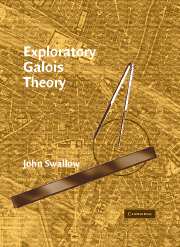Book contents
- Frontmatter
- Contents
- Preface
- Introduction
- 1 Preliminaries
- 2 Algebraic Numbers, Field Extensions, and Minimal Polynomials
- 3 Working with Algebraic Numbers, Field Extensions, and Minimal Polynomials
- 4 Multiply Generated Fields
- 5 The Galois Correspondence
- 6 Some Classical Topics
- Historical Note
- Appendix: Subgroups of Symmetric Groups
- Bibliography
- Index
3 - Working with Algebraic Numbers, Field Extensions, and Minimal Polynomials
Published online by Cambridge University Press: 06 July 2010
- Frontmatter
- Contents
- Preface
- Introduction
- 1 Preliminaries
- 2 Algebraic Numbers, Field Extensions, and Minimal Polynomials
- 3 Working with Algebraic Numbers, Field Extensions, and Minimal Polynomials
- 4 Multiply Generated Fields
- 5 The Galois Correspondence
- 6 Some Classical Topics
- Historical Note
- Appendix: Subgroups of Symmetric Groups
- Bibliography
- Index
Summary
Over any field K ⊂ ℂ, we have associated to each algebraic number α a polynomial mα,K and a field K(α). In this chapter,we consider to what extent these objects are unique, that is, whether a given polynomial or field might be generated by other algebraic numbers β as well. In the first section, we determine all of the algebraic numbers to which a minimal polynomial is associated. In the second, we find that if a field is generated by an algebraic number, it is generated by each of an infinite number of algebraic numbers, and we introduce a notion of size of a generated field. Finally, in section 14 we introduce tools for exploring fields generated by an algebraic number.
Minimal Polynomials Are Associated to Which Algebraic Numbers?
We seek to describe the relationship between algebraic numbers and minimal polynomials as precisely as possible, and we begin by observing how many roots a polynomial may have in a field. We will then relate these roots to linear factors of the polynomial over the complex numbers, and we finally consider what we may say about minimal – that is, irreducible – polynomials.
A Polynomial of Degree n Has at Most n Roots in Any Field Extension
We first present a theorem over arbitrary fields that bounds the number of roots a polynomial may have in a field.
Theorem 11.1. Let K be a field, p ∈ K[X] a nonzero polynomial, n = deg(p), and L a field containing K. Then p has no more than n roots in L.
- Type
- Chapter
- Information
- Exploratory Galois Theory , pp. 39 - 62Publisher: Cambridge University PressPrint publication year: 2004

